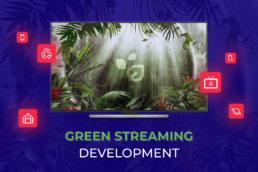The rise of streaming and OTT solutions drastically changed the way consumers access content. These improvements have brought much convenience into the lives of the audience but also put emphasis on significant concerns regarding the carbon footprint left behind. The whole infrastructure, data centers and device usage are energy intensive and contribute to environmental changes. Currently, the media and entertainment industry is taking necessary steps to set new sustainable development standards in order to reduce the impact of streaming on the environment.
The influence of streaming
Content delivery includes various stages that directly affect the well-being of our environment. The amount of energy necessary to store, process and deliver data over the internet leads to a substantial carbon footprint generated by the media industry. The research conducted by Carbon Trust points out that the average European footprint per hour of streaming is estimated to be approximately 55g of carbon dioxide. There is a notable improvement when we compare these results to the previous years. That’s mainly due to the use of newer networks. Although this estimation for playout is comparable to other day-to-day activities there are plenty of ways to make content delivery more environmentally friendly in the future.
What is sustainable development
This phrase refers to an eco-friendly approach to creating software and solutions that meet the market. The main focus is put on maintaining the highest possible development standards and meeting the demands of users while minimizing the negative impact on the environment. It emphasizes balancing the strive for economic growth with actions undertaken to achieve the most sustainable outcome.
Environmentally friendly streaming development
One of the significant aspects that will shape the future of green solutions is sustainable development practices. By adhering to the core rules and strategies for designing and delivering both market successful as well as eco-friendly applications we can contribute to an energy-efficient digital landscape.
Sustainable development goals
1. Code and algorithm efficiency
Efficient and optimized code as well as algorithms increase the application speed and minimize the consumption of computing resources. This leads to reduced energy usage on both sides, the user devices and servers.
2. Adaptive streaming and data compression
Adaptive streaming technics such as bitrate adaptation and buffer management allow for dynamic video quality adjustments based on numerous factors. This way we can provide great viewing experiences while reducing data usage. The same principle goes for data compression, as the name suggests the goal is to minimize the amount of data transmission during streaming.
3. Intelligent Caching
Strategic storage of frequently accessed data lowers the number of transfers and conserves energy while simultaneously improving the comfort of use.
5. Scalability
By designing solutions that can adjust to current demand we can optimize resource allocation, minimize waste and reduce energy consumption.
6. Cross-platform development
Cross-platform development is a sustainable option that proves to be extremely beneficial in regard to the business aspect. The advantages that we often opt for turn out to be also environmentally positive. Quicker time to market, consistent user experience and development that is simultaneous for various platforms add to greater energy savings and streamlining resource usage.
7. Monitoring and maintenance
Constantly keeping up with how the app performs allows you to find areas that are inefficient and quickly act on possible emerging issues. Such practices help in not only optimizing and upgrading the app over time but also mitigating the environmental impact and fostering eco-ware software lifecycle management.
8. Energy efficient UI
Crafting simple user pathways and prioritizing functionality with digital solutions play a pivotal role in sustainable and conscious development. By cutting back on excess resource-intensive elements like graphics or animations we can create not only easier-to-navigate apps but reduce device power consumption.
9. Applying regulations
Proactively adhering to emerging directives regarding data privacy, accessibility and environmental regulations allows for responsible and aware operations. Ethical and sustainable practices help in focusing on lowering the carbon footprint of streaming and OTT development but also on the safety and satisfaction od users.
10. Strategic partnerships and third-party integrations
Cooperating with external partners can expedite the time of solution creation. Harnessing the strengths and expertise of other specialists helps in omitting the need for extra resources. Especially when it comes to creating new development teams, that’s when staff augmentation comes in handy. No resource wasting on internal trainings and on-boarding.
What’s more, utilizing already market-released partner solutions builds a synergestic relationship that fosters increased efficiency and expanded reach. Most importantly in relation to sustainability, you don’t waste energy and resources on building something that has already been created.
Combining sustainability and commercial success
Obviously, sustainability is not the only achievement you expect from your streaming solution. The primary goal is to keep up with the market and do well in in your chosen field. Going for the eco-friendly route can help you in that journey. Unfortunately, but as with everything in live there may be some setbacks.
If you want to achieve true sustainability you have to tackle some technical trade-offs, cost differences, complexity issues, and so on. That’s when you have to decide how to balance these disadvantages with the benefits to promote environmentally friendly options while caring for your own economic well-being. Consulting your concerns with specialists is the best way to reach your goals while implementing sustainable choices.
If you find this article valuable, you can share it on social media →
Read more about the VOD & OTT Industry!
April 25, 2024
What is Connected TV and why is it becoming so popular?
Discover the benefits of Connected TV as it transforms entertainment by delivering internet-powered content through smart TVs and streaming devices.
March 7, 2024
7 reasons why is sports streaming becoming so popular
Learn more about the reasons why sports streaming is becoming more and more popular right now.
February 29, 2024
Why should streaming platforms adapt to changing viewing habits?
Discover the strategies through which streaming platforms adjust to changing viewing habits.
Are you looking for a partner to build a Video Solution?
Leave your email and a short description about your project. We would gladly discuss different cooperation possibilities!





